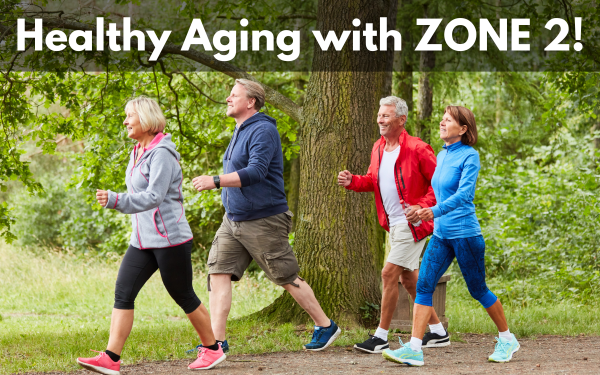Unlocking the Fountain of Youth: The Benefits of Zone 2 Cardio for Living Well
 Aging is an inevitable part of life, but that doesn’t mean we can’t take proactive steps to ensure that our later years are filled with vitality, energy, and a high quality of life. One of the most effective tools in the quest for healthy aging is Zone 2 cardio training.
Aging is an inevitable part of life, but that doesn’t mean we can’t take proactive steps to ensure that our later years are filled with vitality, energy, and a high quality of life. One of the most effective tools in the quest for healthy aging is Zone 2 cardio training.
This often-overlooked exercise method can be a game-changer for those looking to maintain their physical and mental well-being as they age. In this article, we’ll delve into what Zone 2 cardio is and explore its numerous benefits for promoting healthy aging.
Understanding Zone 2 Cardio
Before diving into the benefits, let’s clarify what Zone 2 cardio is. Zone 2 refers to a specific heart rate range, typically around 60-70% of your maximum heart rate. This range falls within the aerobic training zone, where your body relies on oxygen to fuel your muscles during exercise. Zone 2 cardio is often associated with moderate-intensity activities that can be sustained for an extended period.
To clarify what Zone 2 cardio is NOT, let’s consider three of the least beneficial (and even potentially dangerous) exercise trends in the 1980s and 90s.
 OUTDATED TREND #1: “Spot Reduction”
OUTDATED TREND #1: “Spot Reduction”
One common misconception during former decades was the idea that you could lose fat from specific areas of your body by targeting them with exercises. This belief led to exercises like endless crunches for a flat stomach or thigh exercises for slim thighs. In reality, spot reduction is not an effective way to lose fat.
OUTDATED TREND #2: High-Impact Aerobics
High-impact aerobics classes were popular, but they often involved repetitive, jarring movements that could lead to joint and muscle injuries. People would do these exercises on hard surfaces without adequate cushioning, which could be harmful over time.
OUTDATED TREND #3: Fad Diets and Over-Exercising
The ’80s and ’90s also saw the rise of various fad diets and a culture of extreme exercise. Some people believed in promoting overly restrictive diets combined with excessive exercise routines, which often led to nutritional deficiencies, burnout, and injuries.
Unlike the unhelpful trends listed above, Zone 2 cardio activities center around more “natural” movement and are typically performed at a moderate intensity, where you can still hold a conversation comfortably. Here are some of the best examples:
- Zone 2 Walking: A brisk walk where you maintain a steady pace for an extended period.
- Zone 2 Cycling: Riding your bike at a moderate pace on flat terrain or with minimal resistance. (BONUS: Florida is perfect for Zone 2 Cycling!)
- Zone 2 Swimming: A leisurely swim that allows you to sustain your effort and control your breathing.
- Zone 2 Hiking: Walking on moderate trails with some elevation gain, but at a pace where you can talk without gasping for breath.
- Zone 2 Rowing: Using a rowing machine or rowing in a boat or kayak at a moderate pace.
- Zone 2 Elliptical Trainer: Using this machine at a steady and controlled pace.
- Zone 2 Dancing: Moderate-intensity dance styles like ballroom, salsa, or social dancing.
- Zone 2 Aerobics: Participating in low-impact aerobics classes that keep your heart rate up without pushing you too hard.
- Zone 2 Yoga: Certain styles of yoga, like Hatha or Vinyasa, can be performed at a moderate intensity and contribute to Zone 2 cardio.
Remember, the key to Zone 2 cardio is maintaining a steady, comfortable effort level where you can still talk easily. It’s an excellent way to build endurance and improve aerobic fitness.
Benefits of Zone 2 Cardio for Healthy Aging
Improved Cardiovascular Health: Zone 2 cardio workouts help strengthen your heart and improve its performance and efficiency. Regular training in this zone can lower resting heart rate, reduce blood pressure, and enhance overall cardiovascular health. (Hint: this is especially crucial as we age since cardiovascular issues become more prevalent.)
Enhanced Fat Utilization: Training in Zone 2 encourages your body to burn more calories from fat for energy — a valuable tool for weight management and maintaining a healthy body composition, which becomes more challenging as we age.
Joint-Friendly Exercise: Many high-impact workouts can take a toll on joints – especially aging joints. Zone 2 cardio, such as brisk walking, cycling, or swimming, is gentle on the joints while providing a great cardiovascular workout.
Mental Clarity and Cognitive Health: Regular aerobic exercise, including Zone 2 cardio, has been shown to boost cognitive function and reduce the risk of age-related cognitive decline. It can enhance memory, focus, and overall mental clarity.
Stress Reduction: Exercise in Zone 2 triggers the release of endorphins, your body’s natural mood lifters, helping reduce stress and promoting a sense of well-being, essential for mental health in the aging population.
Longevity: Studies have suggested that consistent aerobic exercise, such as Zone 2 cardio, can extend lifespan by promoting overall health and reducing the risk of chronic diseases.
Better Sleep: Older adults often struggle with sleep disturbances. Regular exercise in Zone 2 can improve sleep quality and help combat insomnia, contributing to overall well-being.
Social Connection: Many Zone 2 cardio activities are naturally social, such as group walks, cycling clubs, or swimming classes. Social interaction is essential for mental and emotional health, especially as we age.
The Benefits of Zone 2 Walking After Meals
 One Zone 2 cardio activity particularly effective for overall health is brisk walking, especially after meals. Recent studies highlight its impressive benefits:
One Zone 2 cardio activity particularly effective for overall health is brisk walking, especially after meals. Recent studies highlight its impressive benefits:
- Improved Blood Sugar Control: Research published in Diabetologia found that walking 10 minutes after a meal can significantly lower blood sugar levels. This effect is particularly beneficial for individuals with insulin resistance or diabetes.
- Enhanced Digestion: Walking after eating stimulates digestion by promoting food movement through the gastrointestinal tract, reducing bloating, and preventing post-meal lethargy.
- Weight Management: According to a Journal of Clinical Endocrinology & Metabolism study, walking post-meal increases fat oxidation, helping the body burn calories more efficiently.
- Improved Heart Health: Walking after meals has been shown to reduce triglyceride levels and improve heart rate variability, contributing to better cardiovascular health.
As we face a new year for new beginnings, adding a post-meal walk into your routine can counteract the effects of indulgent meals and maintain your energy levels. Picture this: after a festive feast, gather your loved ones for a 15-20 minute walk to foster togetherness and set the tone for healthier habits this year and every year.
Start 2025 with the resolution to make walking after meals a daily ritual. It’s an achievable, sustainable habit that aligns with the principles of Zone 2 cardio and lays the foundation for long-term health.
Zone 2 cardio is a powerful tool for healthy aging, offering many benefits for both physical and mental well-being. Incorporating regular, moderate-intensity aerobic exercise into your routine can help you maintain vitality, reduce the risk of age-related health issues, and enjoy a higher quality of life no matter how old (or young!) you are. Whether you choose brisk walking, cycling, swimming, or any other Zone 2 activity, consistency and enjoyment are key.
Starting this year, make it a priority to embrace the benefits of Zone 2 cardio. Encourage your family and friends to join you for post-meal walks, fostering both health and connection. There’s no better time than TODAY to unlock the fountain of youth and invest in a healthier, happier you.
When searching for a “chiropractor near me,” you can feel confident directing all your chiropractic care-related questions to Dr. Vivian Ebert of LivingWell Chiropractic in Bonita Springs, FL (on the border of Estero). Visit Dr. Ebert in The Brooks Town Center at the northwest corner of Three Oaks Parkway and Coconut Road.
LivingWell Chiropractic provides state-of-the-art chiropractic care, spinal decompression, medical massage, and nutritional guidance with a holistic wellness approach focused on pain relief for patients with musculoskeletal conditions. Centrally located in Bonita Springs, the office is convenient for patients from Estero, Bonita Springs, Naples, and South Fort Myers.
Posted In:
Live Well Articles
